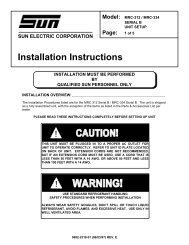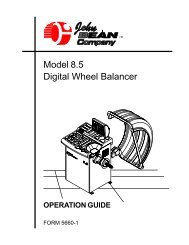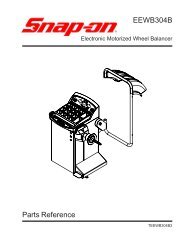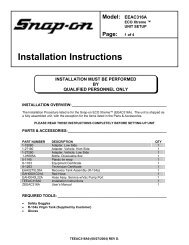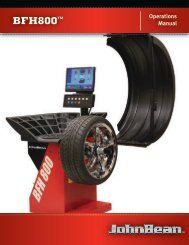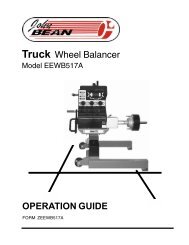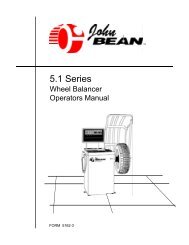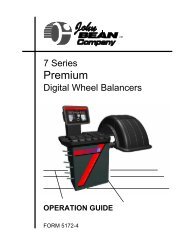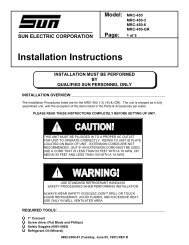700 Series Disk and Drum Lathe Operators Manual - Snap-on ...
700 Series Disk and Drum Lathe Operators Manual - Snap-on ...
700 Series Disk and Drum Lathe Operators Manual - Snap-on ...
You also want an ePaper? Increase the reach of your titles
YUMPU automatically turns print PDFs into web optimized ePapers that Google loves.
8. Now that the Rotor-Truer <str<strong>on</strong>g>and</str<strong>on</strong>g> cross<br />
slide surfaces have been properly<br />
cleaned, place the Rotor-Truer <strong>on</strong> the<br />
cross slide over the adjustable pivot<br />
post. Install a spacer, washer <str<strong>on</strong>g>and</str<strong>on</strong>g><br />
nut. H<str<strong>on</strong>g>and</str<strong>on</strong>g> tighten. See Figure 34.<br />
Adjust the cutting tips to approximately<br />
opposite each other <str<strong>on</strong>g>and</str<strong>on</strong>g> then tighten<br />
the nut with the spanner wrench, locking<br />
the rotor-truer in the operating<br />
positi<strong>on</strong>. See Figure 35.<br />
H<str<strong>on</strong>g>and</str<strong>on</strong>g> Tighten<br />
rate (about 8) for rough cuts, <str<strong>on</strong>g>and</str<strong>on</strong>g> a<br />
slow rate (3 is preferred) for fine cuts.<br />
Knurled screw<br />
operati<strong>on</strong> <strong>on</strong> the other side, if scored.<br />
In many instances, the other side may<br />
be perfectly flat <str<strong>on</strong>g>and</str<strong>on</strong>g> a normal cut can<br />
be taken.<br />
11. With the lathe still running, advance<br />
the cross slide until these cutters<br />
reach the innermost porti<strong>on</strong> of the<br />
braking surface. Turn the knurled<br />
knobs in the directi<strong>on</strong> of the arrow with<br />
micrometer dial wheels past zero to<br />
.003 or .004" to clean up the rotor.<br />
See Figure 36.<br />
Figure 34<br />
Adjust to inner surface<br />
of rotor<br />
Figure 36<br />
A slow rate is also suggested for large<br />
rotors.<br />
10. Turn lathe <strong>on</strong>. If the rotor to be<br />
machined is rough <str<strong>on</strong>g>and</str<strong>on</strong>g> scored, with<br />
grooves no deeper than .010", move<br />
the cross slide until the cutter tip is<br />
opposite the deepest groove. Turn<br />
Be sure set<br />
screws are tight<br />
12. Tighten the knurled screws <strong>on</strong> top<br />
of the rotor truer casting to hold tool<br />
bars in proper positi<strong>on</strong>. See Figure<br />
36. Engage the feed by pulling the<br />
c<strong>on</strong>trol lever <strong>on</strong> the carriage slowly to<br />
the rotor positi<strong>on</strong>. The cutters will<br />
move across the face of the rotor,<br />
machining both sides simultaneously.<br />
On severely scored rotors, it may be<br />
necessary to make more than <strong>on</strong>e<br />
cut. If so, repeat step 11.<br />
13. Normally the finish of the rotor<br />
after machining will meet or exceed<br />
most car manufacturers' specificati<strong>on</strong>s.<br />
If a smoother finish is desired,<br />
an applicati<strong>on</strong> with the 90646 Rotor<br />
Finisher <strong>on</strong> each side of the rotor for a<br />
30 sec<strong>on</strong>d durati<strong>on</strong> will provide a<br />
smooth, n<strong>on</strong>-directi<strong>on</strong>al finish.<br />
Figure 35<br />
Set dial<br />
to zero<br />
T-Slot<br />
Knurled knob<br />
14. Carbide tip cutters last l<strong>on</strong>ger providing<br />
more cuts per tip when the lathe<br />
is operated at low speed.<br />
NOTE: Some rotors have a swept<br />
area <strong>on</strong> <strong>on</strong>e side than <strong>on</strong> the other,<br />
which necessitates adjustment of the<br />
cutters to insure both surfaces are<br />
machined complete at the same time.<br />
NOTE: The T-slot feature, with its<br />
adjustable pivot post, allows you to<br />
machine rotors of all sizes with the<br />
cross slide dovetail ways in full c<strong>on</strong>tact<br />
with carriage. This insures maximum<br />
rigidity of the lathe, while machining<br />
either drums or rotors. See<br />
Figures 36 <str<strong>on</strong>g>and</str<strong>on</strong>g> 38.<br />
9. Select feed rate with scaled dial <strong>on</strong><br />
fr<strong>on</strong>t of lathe casting. Select a fast<br />
14<br />
Figure 37 Groove simulated here.<br />
the knurled micrometer knob <strong>on</strong> the<br />
rotor truer until the cutter tip touches<br />
the bottom of the groove. Now turn<br />
the micrometer dial (next to the knurled<br />
knob) to zero. See Figure 37.<br />
CAUTION!!!<br />
Be careful not to move the knurled<br />
knob which moves the cutter.<br />
Turn the knurled knob in until the<br />
cutter is clear of the rotor. Repeat this<br />
15. When machining is complete,<br />
move the c<strong>on</strong>trol lever <strong>on</strong> the side of<br />
the carriage to the neutral positi<strong>on</strong>.<br />
16. Prepare to remove the rotor by<br />
turning the micrometer dial wheel<br />
counter-clockwise until the cutters<br />
clear the rotor <str<strong>on</strong>g>and</str<strong>on</strong>g> silencers.<br />
17. To remove the rotor from the arbor,<br />
loosen the arbor <strong>on</strong>e turn <str<strong>on</strong>g>and</str<strong>on</strong>g><br />
place the spanner wrench between<br />
the rotor <str<strong>on</strong>g>and</str<strong>on</strong>g> the collet in the outer<br />
bearing race. Push the top of the



